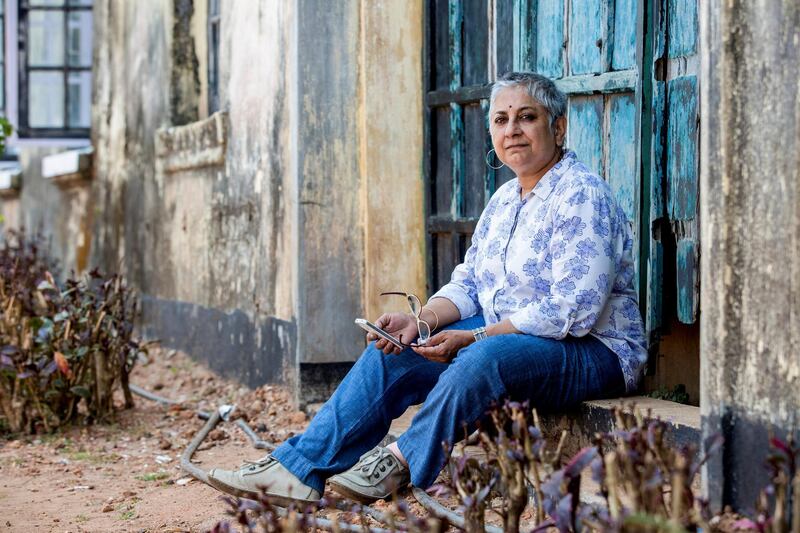Anita Dube was a young art historian in her twenties when she became associated with the Indian Radical Painters and Sculptors Association. The organisation, better known as the Radical Group, was formed of politically active young artists in Kerala who saw art as a site of Marxist commitment rather than bourgeois commodification, valued inexpensive materials and sought to break free from academic traditions then still reigning in Indian art.
Though the Radical Group disbanded in 1989, you can see its impact on the Kochi-Muziris Biennale, which opens today in the Keralan city and which Dube is curating this year. (She is the biennial’s first female curator, as a number of headlines announce, not hugely informatively.) Its influence is everywhere from the biennial’s title, Possibilities for a Non-Alienated Life, with its shades of Marx’s theory of the alienation of labour, to its list of artists, which pairs work by K P Krishnakumar, the driving force behind the Radical Group, with younger Indian artists such as Tejal Shah and Prabhakar Pachpute, and international ones such as Barthelemy Toguo, Goshka Macuga and the Otolith Group.
'Its essence and spirit lives on'
"My long association with the Radical Group was hugely informative of my practice, and the way I think about art and expression, even today," says Dube, who later became an artist as well as a writer. "A central inspiration for the ethos of this Biennale was K P Krishnakumar's Boy Listening sculpture from 1985. Though the work is destroyed, its essence and spirit lives on. Listening, with openness, is a crucial part of the curatorial frame, and I hope that we can all take time to hear voices we have not before: voices in different languages, with different concerns, non-human voices, too."
Dube elaborates this idea by using artworks to provide alternatives to the status quo, specifically on the “topics of gender, race, caste, rural life, urbanity, and the intersections with virtuality and technology”.
Local Kochi artist Vipin Dhanurdharan’s work addresses Indian class division, by referencing the Kerala social reformer Sahodaran Ayyappan, who urged people of all castes to eat together in communal feasts. The veteran feminist collective Guerrilla Girls updates their famous statistics about female representation in major New York museum exhibition to reveal … pretty pitiful increases from 1985. While back then, there was only one solo show by a woman at a major New York museum (at MoMA), in 2015, the number for each of the city’s four major museums had risen by exactly one.
The Guerrilla Girls have translated their placards into Malayalam – one of a number of ways the biennial is extending its reach beyond the art public and towards a local audience. A number of projects take place outside exhibition space, such as politically satirical billboards by Egyptian artist Hassan Khan and cartoonist Andeel, placed around Kochi, and the musical collective Oorali, which went on a tour of the Kerala coastline.
'A sense of responsibility'
To be fair, expanding beyond the art public is the aim of almost every biennial, as the exhibition form constantly seeks to reconcile the arrival of art tourists with the mostly municipally funded events. But the Kochi-Muziris biennial, of which this year is the fourth for the exhibition, has gained a reputation for its genuine openness towards its residents. Dube was keen to develop this aspect, and to build upon the importance of the biennial to the local art scene.
“One of my earliest thoughts in curating concerned the idea that the Biennale is one of the sole pedagogic windows into contemporary art in Kochi, and Kerala at large,” she explains. “While there has certainly been an upswing in institutionalised art activities over the past few editions, I think many of these are hinged on the Biennale’s recurrence, in some way or another. This is why there was a sense of responsibility for me to the local visitor.”
________________
Read more:
The virtual-reality art show that seeks to repair our 'broken connection with nature'
Changing Saudi art scene: New arts complex to open in Jeddah
________________
The Radical Group's belief in horizontal organisation, lives on, too, in Dube's plans for the Pavilion, which she envisioned as a stage that will let things happen, rather than a curated space where they are directed. Her description, perhaps unconsciously, echoes the theme of environmental concerns that runs throughout the show, and ends in a space of openness befitting Kerala's cultural past.
“The Pavilion is designed as an architectural space in which all kinds of activities can happen: performances, informal conversations,” she explains. “It’s a very horizontal design; it works with the environment around it from the trees, light and air flowing through it as a metaphor for conversations, as well as other activities in the Cabral Yard plot. It’s an area that is an open platform to all to contribute something whether a song, poem, film, or comment.”
The Kochi-Muziris Biennale runs until March 29






